SPECIALS


SPECIALS
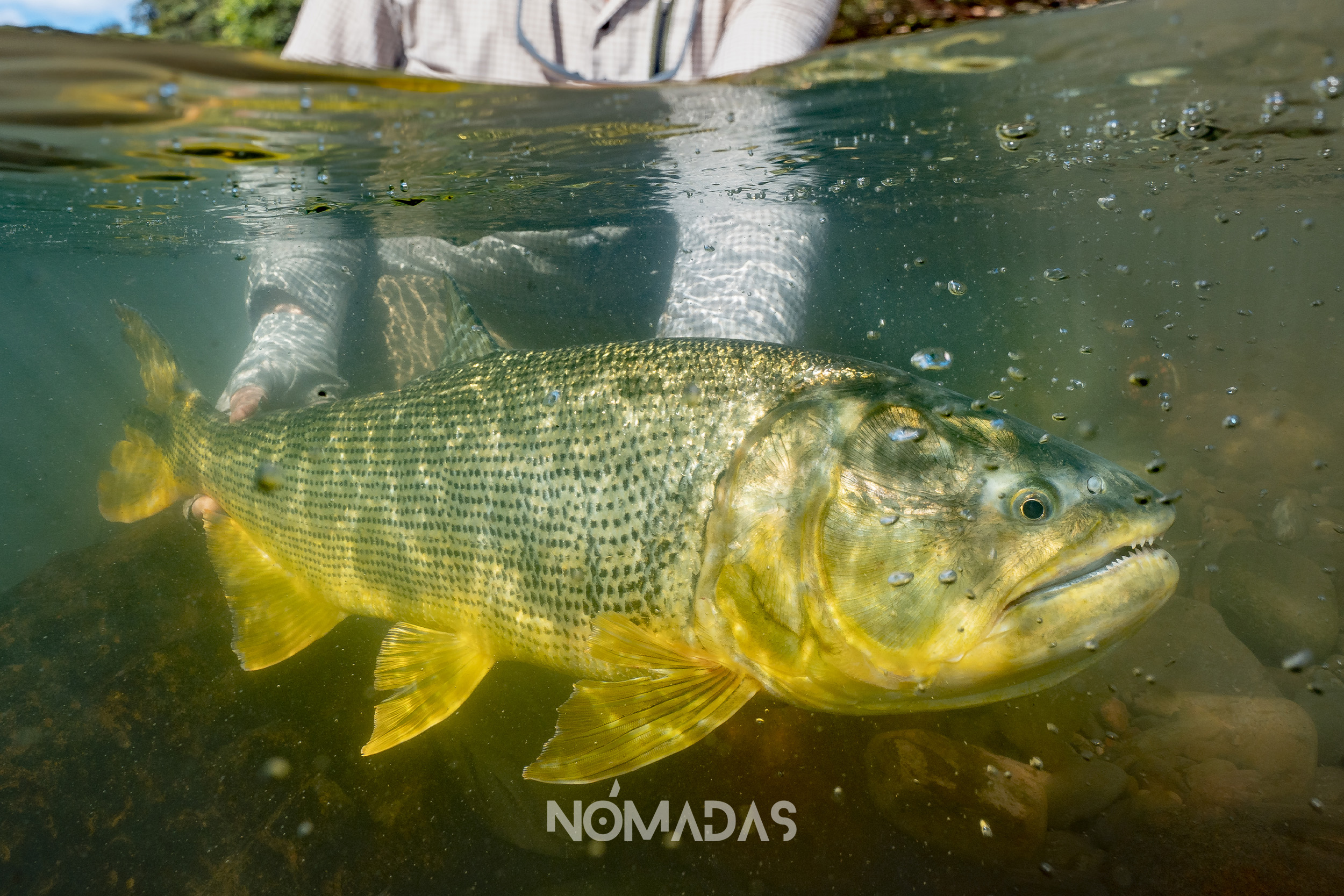
Dorado, after being caught, are returned to the waters of the TIPNIS, which are their domain.
February 8th, 2023
In the rivers of the northern part of the Indigenous Territory and Isiboro Sécure National Park,», reigns supreme the dorado, also known as river tiger, the fish species that «drives international visitors crazy». In this remote part of Bolivia, a tourism project is being developed based on sustainable fly fishing with obligatory return, an activity that puts the brakes on the enemies of the forest.

Roberto Navia
Journalist
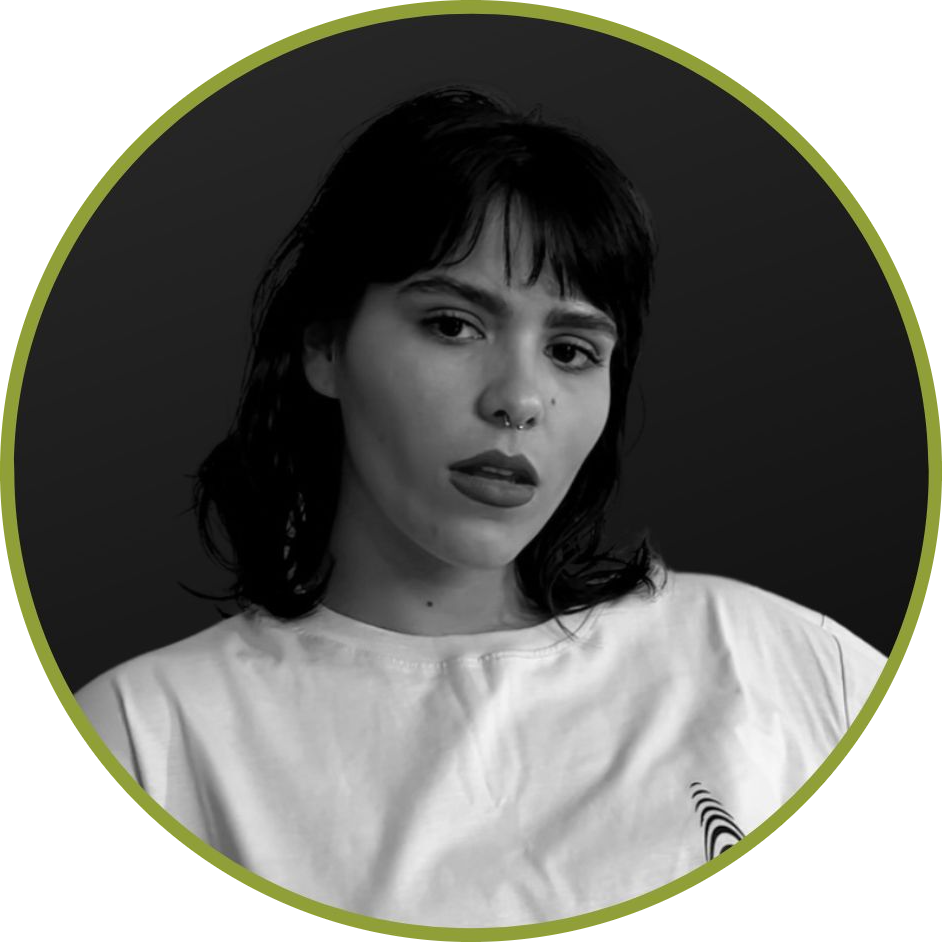
Lisa Corti
Translation to English

Daniel Coimbra
Photographer
Roycer has an eagle’s eye that never fails. He can see – from a long distance – the biodiverse belly of the Sécure River as if he were one more of those who live in its crystal clear waters. One of the most transparent in the world.
Roycer Herbi is a Yuracaré Amazonian indigenous born deep in Bolivia’s Isiboro Sécure Indigenous Territory and National Park (TIPNIS). With his long legs, he moves sure-footed like a feline and with that parsimonious voice of his, he often says with absolute certainty:
This model of sustainable tourism, in turn, is a shield against unhealthy threats within the rainforest, such as drug trafficking, deforestation, illegal mining, land trafficking and, therefore, forest fires.
-Be careful, there’s a big Dorado over there!
When he says that, when he also points with his index finger in the direction where he has detected the movement of a specimen of one of the most valuable and admired fish species on the planet, a huge smile appears on the face of the fisherman next to him, who has traveled hundreds of kilometers -or perhaps thousands- to reach this remote spot on the planet; on the face of the fisherman next to him, who has traveled hundreds of kilometers -or maybe thousands- to reach this remote point of the planet, a huge smile is drawn because in a few seconds he will be fighting with the monarch of the fish and -after a short but intense battle- he will fall surrendered to the beauty of the iridescent body and the deep eyes of the master of the river and -after catching his breath- he will let him go as one let go of a good friend. Then, the dorado will advance without haste and its silhouette will be lost before the fisherman’s grateful eyes; but Roycer, who knows how to interpret the language of the forest, will continue to observe it until it gets lost in the depths of the gentle waters of the Sécure, and he will wish to be one of them because Roycer likes nothing better than to swim as free and plethoric as a fish in these rivers that are part of this territory that is still one of the best preserved in the world, thanks to the fact that in the northern part of this protected area, an ecotourism activity is developed that scares away the enemies of the forest: sustainable «fly» and «catch and release» fishing.
The TIPNIS is such a privileged place on the planet that the French naturist and expeditionist Alcides D’Orbigny – who explored Bolivia between 1830 and 1833 – described this Amazonian region of Bolivia as «the most beautiful jungle in the world».
And surely D’Orbigny was not wrong in describing this impressive piece of the planet with those words. This area, where the project of catch and release fishing is developed, is a transition area between the Amazon basin and the mountains that rise slender and kiss the humid clouds that give magnificent and generous rains and sunsets that, in beauty, compete with the sunrises that do not rest because stress, here, is something that has not yet been invented.
The TIPNIS is a protected area of 1,236,296 hectares (12,363 km²) -almost twice the size of the city of São Paulo, Brazil- that has two protective shields: it has been a National Park since November 22, 1965 and an Indigenous Territory since September 24, 1990. In this green universe, it harbors an enormous amount of life so important that, after Madidi National Park, the TIPNIS is one of the most biodiverse protected areas in the world.
Geographically it is located between the departments of Beni (province of Moxos and municipalities of San Ignacio and Loreto) and Cochabamba (province of Chapare and Ayopaya and municipalities of Villa Tunari and Morochata). But its importance is not only in this epicenter of splendid nature, but from these places it drives the development of life throughout the globe.
The indigenous Yuracarés, Tsimanes, Moxeños, and Trinitarios know that the titles of National Park and Indigenous Territory are very important, but that they are not enough guarantees to protect this essential territory for them. They know that several enemies do not sleep, that the forest is a constantly coveted jewel, that this northern part of the TIPNIS is one of the few almost untouched places in the South American continent, that the exuberant vegetation helps the environmental balance of the planet and that, if something bad happens here, they will be the first to be left without house or food or rivers or trees or rains or future happy days.
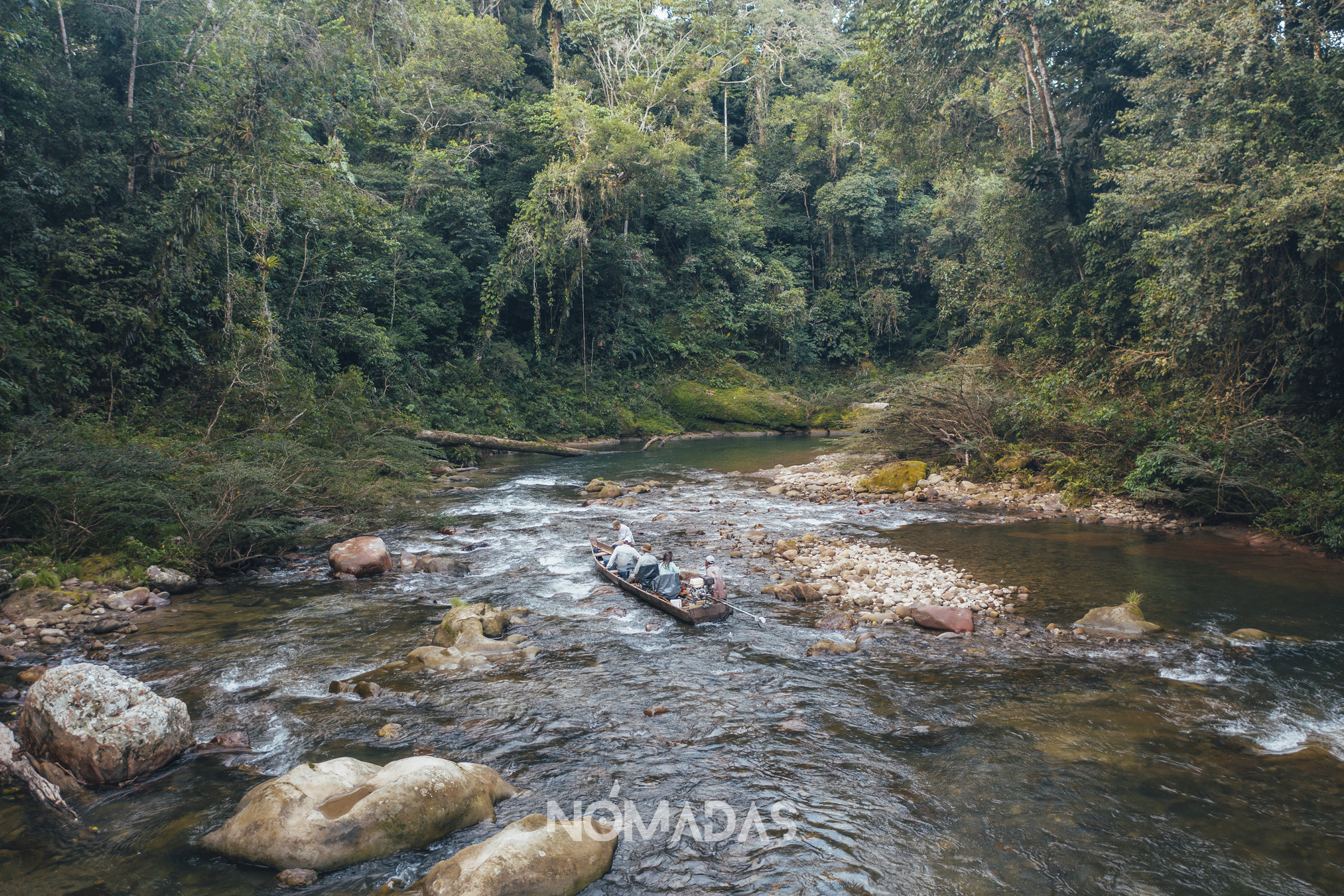
They arrive from distant lands, for a few days, to meet the dorado head-on and to enjoy a forest that cares for humanity.
They also know that it would be useless to sit back and watch the enemies of nature pass by or to complain in silence about the eternal neglect of the State or the lack of economic resources of the indigenous families that inhabit the TIPNIS. They have decided to take advantage of the natural treasures that inhabit the depths of the jungle and develop a sustainable tourism program using the Amazonian Dorado as the magnet capable of attracting tourists who love «fly fishing», a sustainable fishing model with the return of the fish to the river and with a deep respect for the indigenous culture.
Outside Bolivia, especially in the United States and in some European countries, fly fishing is an activity that has a large number of followers.
-You catch the fish, but you don’t kill them,» says Roycer, as his strong, bare feet walk along the Pluma, one of several rivers that bathe the TIPNIS.
This model of sustainable tourism, in turn, is a shield against the insane threats within the jungle, such as drug trafficking, deforestation, illegal mining, land trafficking and, therefore, forest fires. Roycer Herbi also knows this, as do his parents and grandparents and the neighbors of the communities who, far from having remained with their arms folded, chewing their historical needs in silence, since 2009 have been captivating a foreign public, attracted not only by the Dorado, an emblematic fish that is not native to the Amazon basin but that, for some reason, the TIPNIS is lucky to have it in its rivers and its inhabitants have found the formula to take advantage of nature without harming it.
Outside Bolivia, especially in the United States and in some European countries, fly fishing is an activity that has a large number of followers. It consists of a fishing modality that uses a rod and an artificial lure called fly that is mounted on a «bait without death or burr», that is to say, without that sharp hook-like splinter, in order to guarantee the minimum damage to the fish so that the fisherman returns it to the water immediately. The hook is coated with artificial materials (different types of fibers) or natural materials (feathers, deer hair), imitating food options for the dorado: small fish, insects, fruits, among others.
The fame of this offer is such that every year more than 400 people arrive in weekly packages, the vast majority from the United States, pushed by the fame that the TIPNIS is among the most prestigious international destinations for sustainable fly fishing and is considered without discussion the best place in the world to fish for the great dorado, which for the natives is the jaguar of the rivers, because this species of fish is key in maintaining the structure and function of the ecosystems it inhabits, since being a predator par excellence, it maintains the balance in the food chain and controls the populations of other species in the areas where it lives.
None of this would have been possible if the indigenous people, owners of the territory, had not created the Indigenous Tourism Association of Sécure Alto, together with the company Untamed Angling (a corporation incorporated in Beni in 2008.), to make the Tsimane project a reality, which is the visible brand of the sustainable fishing offer shown worldwide.
This work structure, according to both parties, allows the project to be not only successful, but also sustainable over time, always with the objective of nature conservation, species protection and respect for the culture of the indigenous communities that have inhabited this region of Bolivia since time immemorial.
The indigenous people are the owners of the enterprise, they have the environmental license, make their cultural knowledge available and share it with visitors. The company, for its part, carries out the administrative, logistical, marketing and maintenance work for the three lodges: Sécure Lodge, Agua Negra Lodge and Pluma Lodge, which are named after the nearby river where they are located and operate from May to October each year, from the end of the rainy season until the rain begins to fall and the water levels rise.
In the TIPNIS, rivers are the soul of the forest. They are the music that accompanies every living being that inhabits the territory. The song of the waters travels through the many shades of green that paint the forest and warns the animals of the way to come out to quench their thirst, to wash off the heat with a routine bath, to quench their hunger with the food that inhabits their inner world. A tapir makes its way through the branches, walks steadily to the shore and steps into the warm waters of the Sécure. Its nose is the only thing left on the surface, it moves like a restless worm trapping the air that the animal’s body needs to enjoy without fear of the men who are meters away from it.
It consists of a fishing modality that uses an artificial lure called fly that is mounted on a «bait without death or burr», to guarantee the minimum damage to the fish so that it is immediately returned to the water.
Those on the other side of the river love the silence.
The quartet of men is composed of two fishermen who have arrived from the United States, two guides who complement each other like two nuts of the same piece: one of them is an indigenous man who learned his trade in the jungle school, and the other has been educated in the academy and came to the TIPNIS with his experience of the world under his arm. Both are the eyes of the fisherman, those who, when they glimpse the golden back of a fish, say it without shouting, excited, but they know that -in order not to make noise- they must do it with that piano voice that comes from the cavern of their throats.
The fisherman, who has traveled at least 4,000 kilometers from the United States, excitedly swings the thin rod and the line swings through the air like a ribbon that with the weight of «the fly» falls centimeters away from the animal. When the dorado bites, it leaps into the air, showing itself whole under the jungle sun, and the battle between man and animal begins. The fish has bitten the barbless hook with its strong teeth and clenched with its prominent jaws. The fisherman tries to bring it to the shore, but the strength of the dorado is such that he must give it line and when he sees that it is going too far, he will bring it towards him, but he will avoid tightening that thread that exists between them, that communicates them, that distances them, that unites them, that turns them into momentary enemies, into two gladiators that have turned the Amazonian river of the TIPNIS into a Roman Circus. If the line becomes too tense it will run the risk of breaking, then, the fisherman will remain with his head down, as if he were going to the greatest of his failures; but if he knows how to handle the situation, if he controls the animal’s strength and does not succumb to its pirouettes in the air as if it were a devilish colt, he will manage to control it and when he notices that the dorado has exhausted all his strength, he will go to it, put his knees in the water, take it by the lower part of the body, will take the «fly» out of his big mouth, will let him rest in the water, will wait for him to recover his strength and then -only then- will open the doors of his hands and let him go under the eyes of his two guides who also feel part of the battle where there are no winners and no losers.
Allen Gillespie came from the USA and is one of the hundreds of fishermen who came to the TIPNIS in 2022 in search of dorado. Fishing is ingrained in his skin. The house of his early years was a few meters from a river and with that proximity he started fishing when he was five years old. When he was 20 years old, he learned about fly-fishing and catch-and-release fishing and, since then, he has traveled the world in search of rivers where he can fish in a sustainable way, respecting local cultures and the environment.
When Allen is on the banks of the river, he feels that the daily problems of life are lulled away by the calm swaying of the waters.
-This place is impressive, says Allen, at nightfall, after having spent the day soaking his boots in the waters of Tsimane, walking back and forth, with his fishing rod in his hands, with a broad smile when he felt he had caught a fish, with sweat on his forehead in the middle of a fight, with the final goodbye after taking the hook out of his mouth with sharp teeth, after releasing him to swim away in his own waters.
-I hope we meet again,» he says silently to the dorado, to whom he declares his admiration because he knew how to fight with all his strength and that, in the end, already out of breath, the animal surrendered to the fisherman, perhaps as an act of trust, perhaps determined to die.
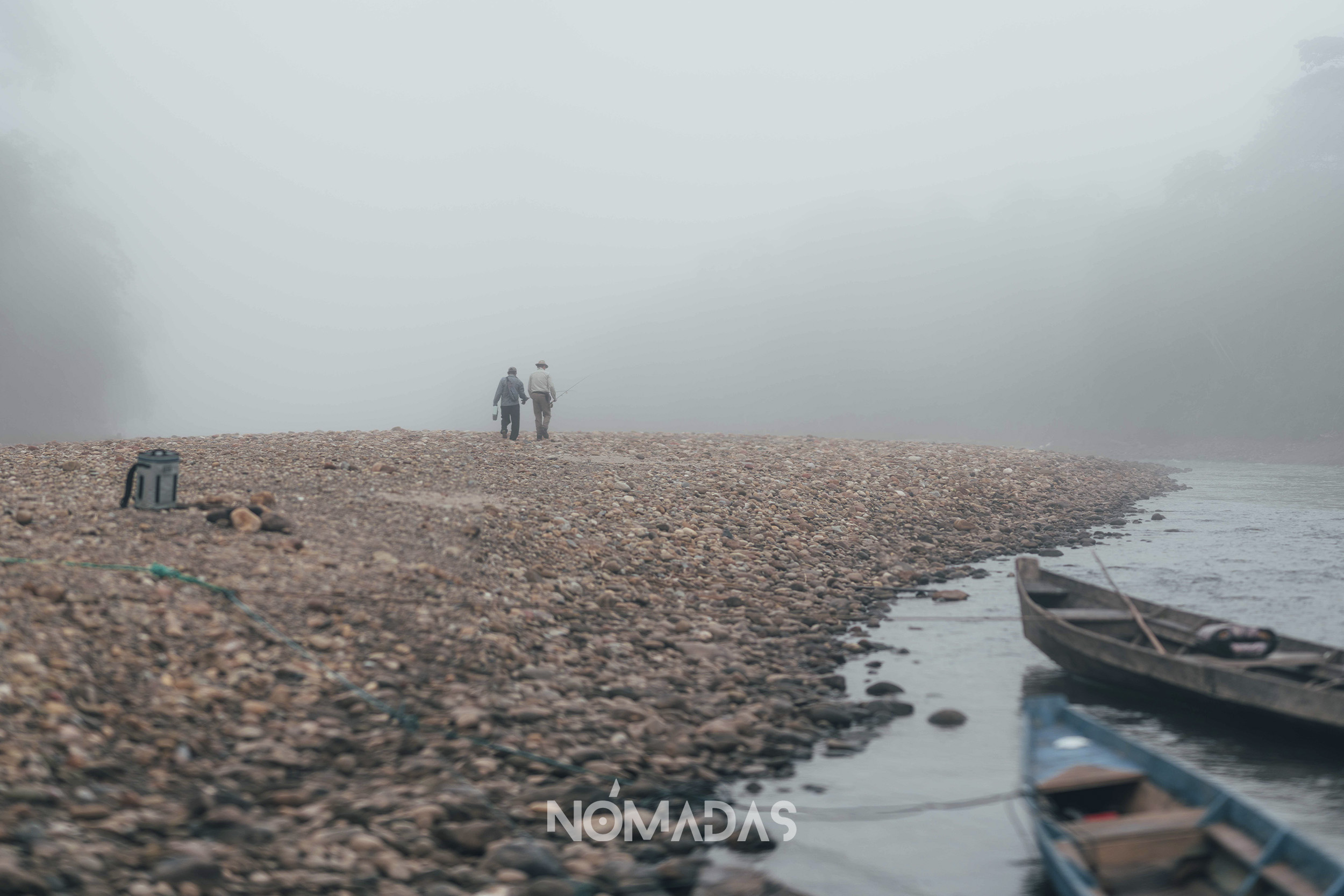
Sustainable fishing with return also implies walking through the mist that, step by step, reveals the beauties of the TIPNIS.
Allen is now enjoying the cool of the evening on the terrace of the Pluma Lodge, the flagship of the three lodges that were built in the TIPNIS. It is a kind of five-star hotel in the middle of the tropical forest, illuminated by a good moon and by the electric energy produced by a generator that purrs surrounded by slender trees, a scenario with wooden rooms overlooking the river and vegetation that makes you feel that you are surrounded by the most beautiful creation of this planet.
The fame of this offer is such that every year more than 400 people arrive in weekly packages, most of them from the United States, driven by the fame of the TIPNIS.
In the cabins of the three lodges, guests sleep peacefully in comfortable rooms and enjoy seasonal fruit juices and a menu prepared by chefs who not only love cooking, but are also capable of bringing the lively aromas of nature to the plate.
It was not easy to build this cathedral of ecotourism in the middle of Bolivia’s Amazon forest. Marcelo Pérez has been the visionary who -on his Atlantean shoulders- has supported the weight of a monumental work comparable to a silent epic that he was able to build -first in his dreams- and then in the reality that he can now touch and offer to the whole world.
The basic services of the cities, those that seem so normal, such as Internet, electricity, drinking water and hot showers, are also present here. And this is not a miracle or something similar, but the result of a team work that Marcelo Pérez – who is the director of Tsimane – tells with the natural talent of an oral narrator, as if it were a fictional novel or a film that deals with a titanic project.
It all began in 2006 with the first explorations, the environmental procedures and permits, and the agreement between the indigenous people and Untamed Angling, of which Marcelo Pérez is the head. Three years of paperwork to then raise in the middle of the Amazon jungle what at that time seemed unthinkable. A to and fro of canoes on the rivers for days and nights, crossing cache and rapids, transporting equipment and construction materials: from a nail to an electricity generator of several tons.
Marcelo was moving in trucks along the dirt roads that lead from Trinidad to San Ignacio, he sailed tirelessly, from sunrise to sunset, in the canoes of the indigenous people who welcomed him as one of their own and he also flew in small planes when it was time to speed up the construction of the cabins that already had a date and time to receive visitors.
Adolfo Guarachi Flores, who arrived from El Alto to work with an entire team made up of indigenous people and others from different parts of Bolivia, recalls with obvious nostalgia: «We transported the generator from Trinidad, by land and by water. A week’s journey in a canoe 18 meters long. There is an area where there is no beach and only ravines on the sides. You can’t even go down to relieve yourself, two days and two nights of pure water.
The greatest adventure was not transporting the generators by canoe, but rather, getting them up to the site of the cabins. The sum of strategy and collective strength. At least 30 men gave their physical strength to lift and move the metallic apparatus that now gives light during the warm nights in the middle of nowhere or – better said – of all the immensity of the jungle.
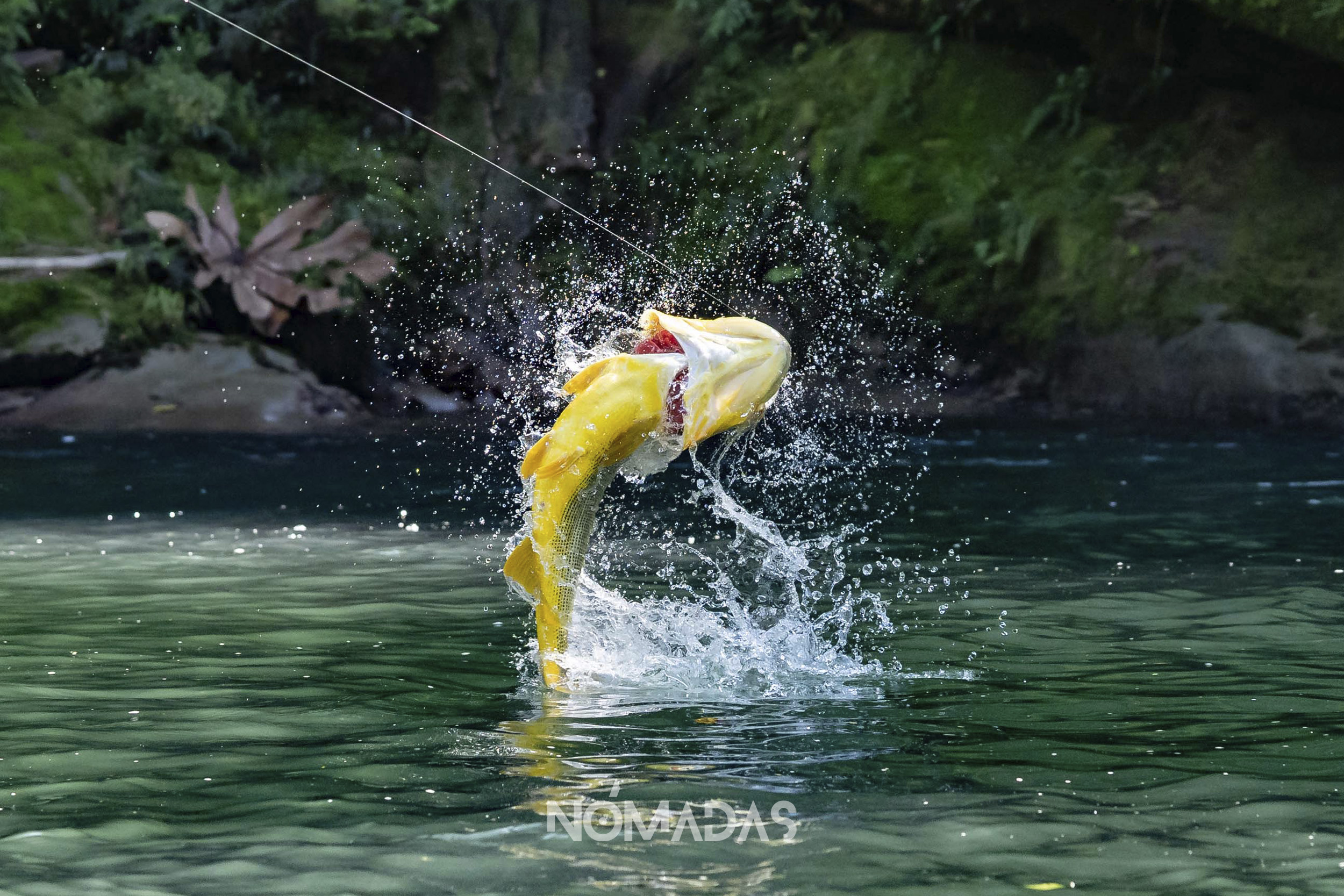
The dorado is not an easy prey. In the water it has the strength of a railroad and in the air the dexterity of a feline.
The generator supplies electricity to all the rooms, the dining room and workers’ rooms until a certain time at night, and then gives way to solar energy, which is available for any need they may have in the early hours of the morning.
In the cabins of the three lodges you sleep peacefully in comfortable rooms and enjoy seasonal fruit juices and a menu prepared by chefs who are able to bring the living aromas of nature to your plate.
In addition to the construction materials, masons and carpenters, plumbers and electricians from Trinidad also arrived. A team of workers numbering around 70 people, who joined the indigenous people who were also indispensable in the gestation of the shelters, many of them great navigators who, with the necessary loads, sailed the rivers against the clock so that the work would not stop.
Workers began their chores before sunrise and finished at midnight. On August 8, 2009, the first visitors arrived from the United States and the Ecolodge was completed just before they set foot in the TIPNIS Amazon forest.
«This recreational activity generates economic resources to protect 1.2 million hectares of the TIPNIS and the culture of 33 indigenous communities and their organizations,» says Marcelo Pérez, and recognizes that, if this fishing with return project did not exist, this region would surely be like many protected areas and indigenous territories in South America: threatened or directly intervened by illegal activities, illegal mining, encroachment, fires and deforestation.
«This project works as a protective shield, because everything illegal escapes from the places where sustainable tourism is developed,» he emphasizes.
Two misfortunes also happened in this story: in different years, the rivers, after their seasonal floods, knocked down the two original ecolodges, the one on the banks of the Sécure and also the one on the Pluma.
-I couldn’t believe it. We have to make another one,» said Adolfo to Marcelo.
Everything had been washed away. Only the kitchen and the rooms where the staff slept were left.
Fortunately, the misfortune occurred in rainy weather, when the shelters are uninhabited, meaning, out of season.
Marcelo Pérez, who was born in Buenos Aires, is an architect by profession and a promoter of sustainable tourism as a mechanism to protect nature, remembers how the indigenous people downstream were also stunned when they saw the cabins drifting on the white waters.
Working against the clock, they were able to build and equip the new lodges in higher altitude areas and in time so that the season would not be affected, since visitors already book their stay even one or two years in advance.
Far from abandoning the project, Tsimane’s growth has been increasing. The international image and demand has led to the launch of Heli Fishing, a new program «that takes anglers into the untouched jungle experience,» starting in 2022. Visitors stay at the new Pluma Lodge and the Sécure Lodge and from there fly by helicopter for five to 10 minutes into the untouched waters«.
The helicopter, which seats four passengers, skims the horizon with the skill of a bird. On the other side of the windows are the leafy treetops, the wild flowers that paint the forest in colors that often kiss the yellow-bellied clouds. From above you can also see inside the rivers because the waters – crystalline as they are – hide no secrets. The white sandy beaches serve as a heliport for smooth landings and when the metallic bug is gone, the jungle delivers the songs of the birds as one of its greatest symphonies.
***
Visitors arrive in Santa Cruz from their international destinations. Here they sleep one night. Then, they depart on a charter flight to Oromomo, the community where indigenous Tsimanes and Yuracarés live. There, they are waiting for them with the canoes ready to navigate the Sécure River. A one-hour trip that allows travelers to feel the living force of the jungle, the soft wind on their skin, contemplate the vegetation that is gradually giving up its mountain scenery and if they are lucky, they will see some wild animals that come out to the shore to sunbathe or water without haste or time.
The white sandy beaches serve as a heliport for smooth landings and when the metallic bug is gone, the jungle delivers the songs of the birds as one of its greatest symphonies.
On the trails in the communities of Oromomo and Asunta there are park rangers who register the arrival of all tourists, noting the name, passport, date of arrival and departure.
The TIPNIS park rangers have also been strengthened by the fly fishing project. The project provides them with boats, motors, gasoline, food, and logistical support so that they can move around during their routine operations. In addition, the National Service of Protected Areas (SERNAP), receives a SISCO (Collection System) for each tourist, which is considered the highest in Latin America, and reaches, for the entry of more than 400 tourists per season, a collection of more than Bs 380,000. These resources are deposited in an account of the Ministry of Environment and Water and help to practically cover the park’s annual costs.
The business model is that, of the net profits each year, the indigenous communities keep the equivalent of 50 percent and the company bears all operational risks, investments, and maintenance of the Ecolodge. At the end of each season, Marcelo Pérez and his management team present the accounts in one of the TIPNIS communities, in a general assembly supervised by SERNAP, and deposit the money in an account that the Indigenous Association has opened for this purpose.
«From 2022, they will receive about three million Bolivianos, between royalties and salaries for the work they do in different areas. There are indigenous people who act as guides accompanying the fishermen, others are boat pilots, cooks or do maintenance work, sell handicrafts, and take care of the cabins,» says Marcelo, who also explains that, of the total amount that they receive, the Indigenous Tourism Association keeps 50% of the royalties and the other half is shared with the 17 communities that exist on the banks of the Sécure River and also with a dozen communities that exist in the southern zone of the TIPNIS.
In Oromomo, the indigenous people proudly show the results of the investments they have made with royalty money. They have nine water purification plants that take water from the river, transport it with the help of a motor pump to a tank and make it drinkable without fear of getting sick.
Javier Beltrán is the doctor who treats Oromomo and nine other communities. Over the years he has seen how, despite all the problems of living in a place that historically was not attended to, the quality of life has been improving little by little. He knows that water is an important factor for health, but also food. In this last aspect, he says that the challenge they face is to improve the diet to ward off the ghost of malnutrition because the indigenous people of the TIPNIS do not have a balanced nutritious diet. They eat carbohydrates and proteins, but lack vegetables.
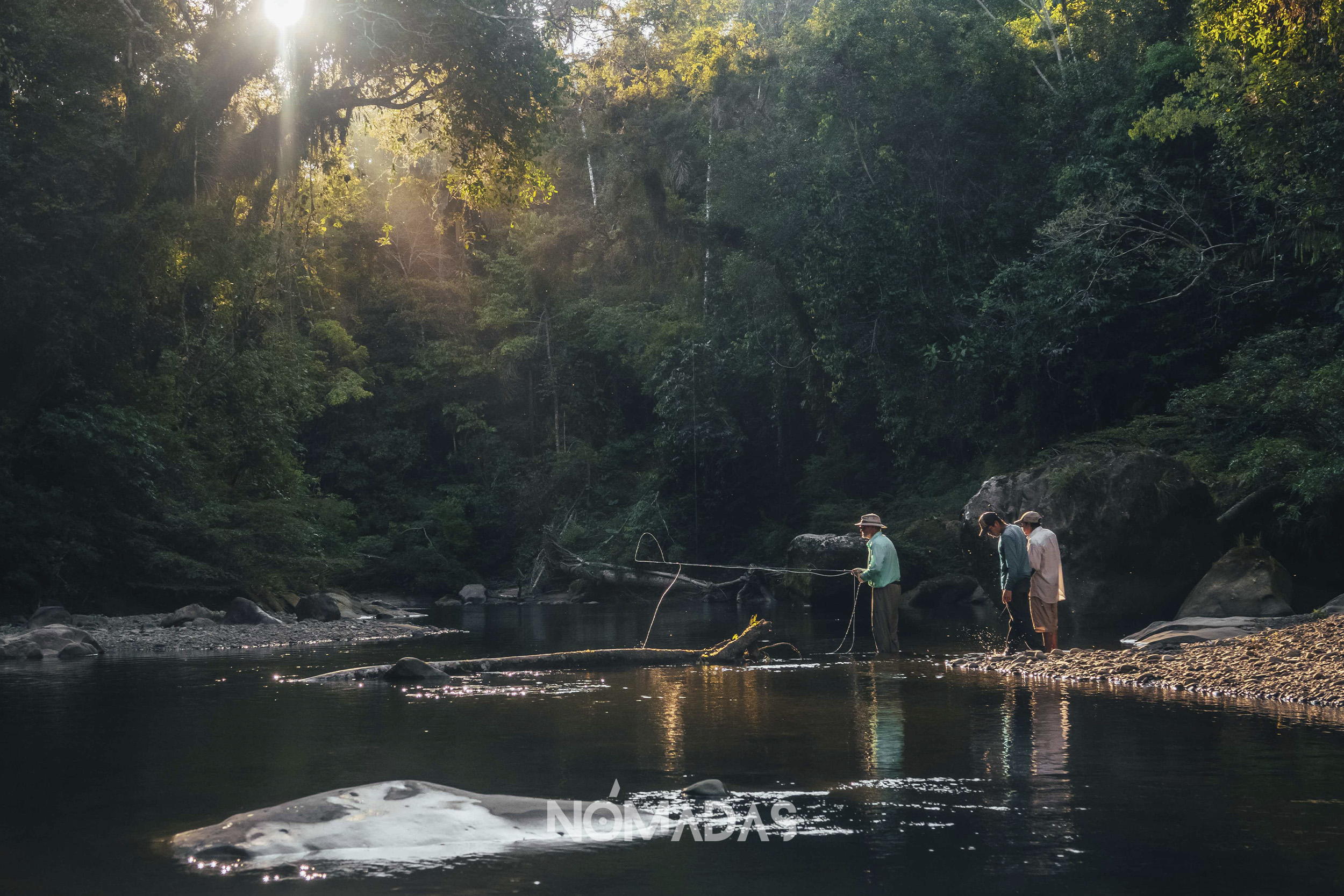
A postcard scenery. The bowels of the TIPNIS.
So, the plans they have in Oromomo and in other communities is to promote family gardens. This makes Dionisia Herbi, who is now working at the Pluma Lodge camp, very happy. She is in charge of cooking for the guides of her community and others who are accompanying the fishermen, cooking on the stove that she carefully stokes.
The basic services of the cities, those that seem so normal, such as Internet, electricity, drinking water and hot showers, are also present here.
From this corner of the TIPNIS, Dionisia can also communicate via WhatsApp with her relatives living in other parts of the Amazon, thanks to the fact that, with the resources they receive from sustainable tourism, they have been able to erect the antenna and receive satellite Internet service.
Water transport has also been strengthened because fuel, which was a major problem, can now be purchased more easily and trips lasting days and weeks can be planned to Trinidad, but also to towns along the riverbanks.
The rivers, in the TIPNIS, are the highways of the indigenous communities, and the peke peke motors – mounted on narrow wooden canoes approximately 10 meters long by 1.5 meters wide – are the wings and feet of their inhabitants who move from one place to another to go fishing, to hunt, to visit their relatives; as ambulances when they need to take a sick person to a big city and -in general- as a way of life that cannot be conceived without the river and without those rafts with which they discover their territories every day.
The peke peke moves forward at a steady pace. In the curves of the river, the engine sounds like a tired breath, but full of vigor. The Sécure is like an immortal cobra, whose body of water is a cradle where dorados and tarpon, pacúes and catfish live and is also the source that quenches the thirst of every living being that inhabits this land of indigenous people who welcome sustainable tourism with open arms.
The indigenous people have been divided into groups that work in the Sécure Lodge, Pluma Lodge and Agua Negra Lodge for two weeks and, in this way, they can have the opportunity to work with most of the neighbors from different communities.
When they return to their homes, they arrive with the money they have earned, which they use to buy food or to keep in reserve for any mishap. It is like when they go hunting for subsistence, after several days in the bush, they return with the meat of wild animals with which they feed their families.
The fishing project has not intervened in the culture and nomadic lifestyle that the indigenous people have treasured since time immemorial.
***
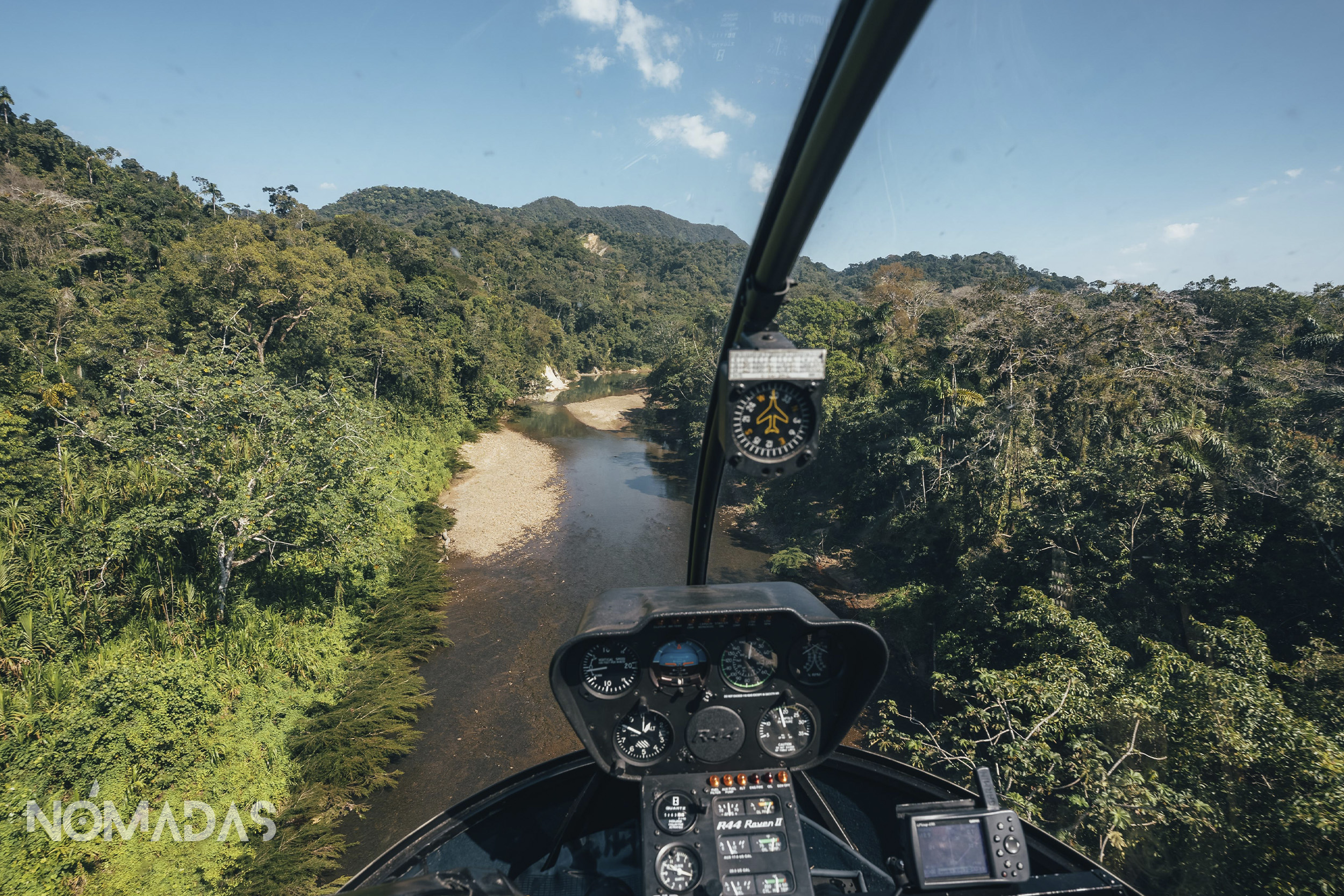
Heli Fishing, a new program «that takes anglers into the untouched wilderness experience».
Michela Ribera walks with aplomb along the banks of the Pluma River in search of dorado, which she calls a magical fish. Born in Trinidad, she learned to fly fish when she started working in practically all the functions of the Tsimane project, back in 2009, where she is now customer service manager and also promotes marketing as the protagonist of the videos they film to promote the fly fishing offer worldwide.
It all started in 2006 with the first explorations, the environmental procedures and permits, and the agreement between the indigenous people and Untamed Angling, of which Marcelo Pérez is the head.
«The dorado is among the five most valued fish in the fly-fishing world», Michela emphasizes and says that the project goes beyond fishing: «Tsimane is an exceptional experience, from the moment the visitor arrives in Bolivia and enters the jungle».
The sensory experience is a swaying of the sounds of birds and insects, of unique images that the forest offers, of encounters with animals that, not having had contact with bad men, do not run to hide because they feel that their lives are not in danger. The tracks of the jaguars on the river bank are a constant, as are those of the tapirs and a whole community of wild animals that – as is the case of the monkeys – seem to wave from the branches of the trees.
Michela crunches the numbers and says that 90% of the clients who come to the TIPNIS are from the United States, the rest from European countries and some come from South Africa, Asia and Latin America. The trip package consists of nine days: seven days in one of the three Ecolodges and two nights in Santa Cruz, at the entrance and at the end of the trip.
The country’s name is looking good at the international level, says Michela Ribera, who highlights the complementary work that exists between the company she manages and the indigenous people of TIPNIS: «We provide the hotel service and all the logistics and promotion work worldwide; and the indigenous people are the ones who have the ancestral knowledge of their culture and nature, they are the ones who best understand the jungle and also those who open the trails for the fishing circuits. They know the riverbeds and the changes produced by the rains. The fly fisherman is a very environmentalist person, he leaves the smallest trace of his presence in the place«.
The meat and other products used to prepare the food,» says Marcelo Pérez, «are brought from Santa Cruz, and the project does not hunt or fish any animal that lives within the TIPNIS. The lodges do not eat dorado or any other species that inhabit the rivers of this Amazonian region of Bolivia.
«All inorganic garbage generated in the shelters is collected in dumpsters and taken by canoe to Trinidad to be transported to the municipal landfills,» explains Tsimane’s director.
***
Alejandro Gatti arrived from Argentina to work as a guide for anglers at Pluma Lodge. «We act as a link so that the client can achieve the fishing, that is to say, we give him indications on where to fish and where not to fish, where to advance, where to stay still, where to make long or short fly casts».
The helicopter, which seats four passengers, soars over the horizon with the skill of a bird. On the other side of the windows are the leafy treetops, the wildflowers that paint the forest in colors that often kiss the radiant clouds on the horizon.
What a guide does is read the river to the angler.
«Each river has an infinite number of currents. You have to know how to interpret them so that the «fly» falls in front and as close as possible to the dorado, which is an innate predator. When the water is clear, the fish positions itself more in the middle of the river, but when it is dark, due to rain, the animal moves closer to the shore. Alejandro explains that he has learned this knowledge through studies, reading books, watching documentaries, and talking a lot with experienced people.
What Alejandro has learned in the academy and also empirically, the native guides have received through the knowledge imparted to them by their grandparents and parents. Reading the river, for the Tsimanes and Yuracarés, is something innate. And in this work, what both guides -the ones who came from Argentina, like Alejandro, and the native ones, like Roycer- do is to complement each other, to enrich their knowledge. One is an expert in fly-fishing and speaks English -which makes it easier to communicate with the American visitor- and the other has a privileged view that allows him to spot the fish from a long distance. The one knows at what distance the «fly» should fall in front of the animal, and the other knows how to walk along the river banks so as not to scare the dorado and also knows how the angler should catch it after he has caught it, without hurting it, and at what moment he should return it to the river.
In each of the three Ecolodges there is a dining room finely decorated with the photographs of Daniel Coimbra Fernandez, an artist of the image that comes walking the rivers with the greatest of enthusiasm and observing the details of the jungle that later turns them into a graphic. The dining room of each lodge serves international food with culinary aromas of the forest and high altitude wines from Bolivia, Chile and Argentina.
After dinner, the visitors stay to talk about their exploits, about how amazed they are with the landscapes and biodiversity of the TIPNIS.
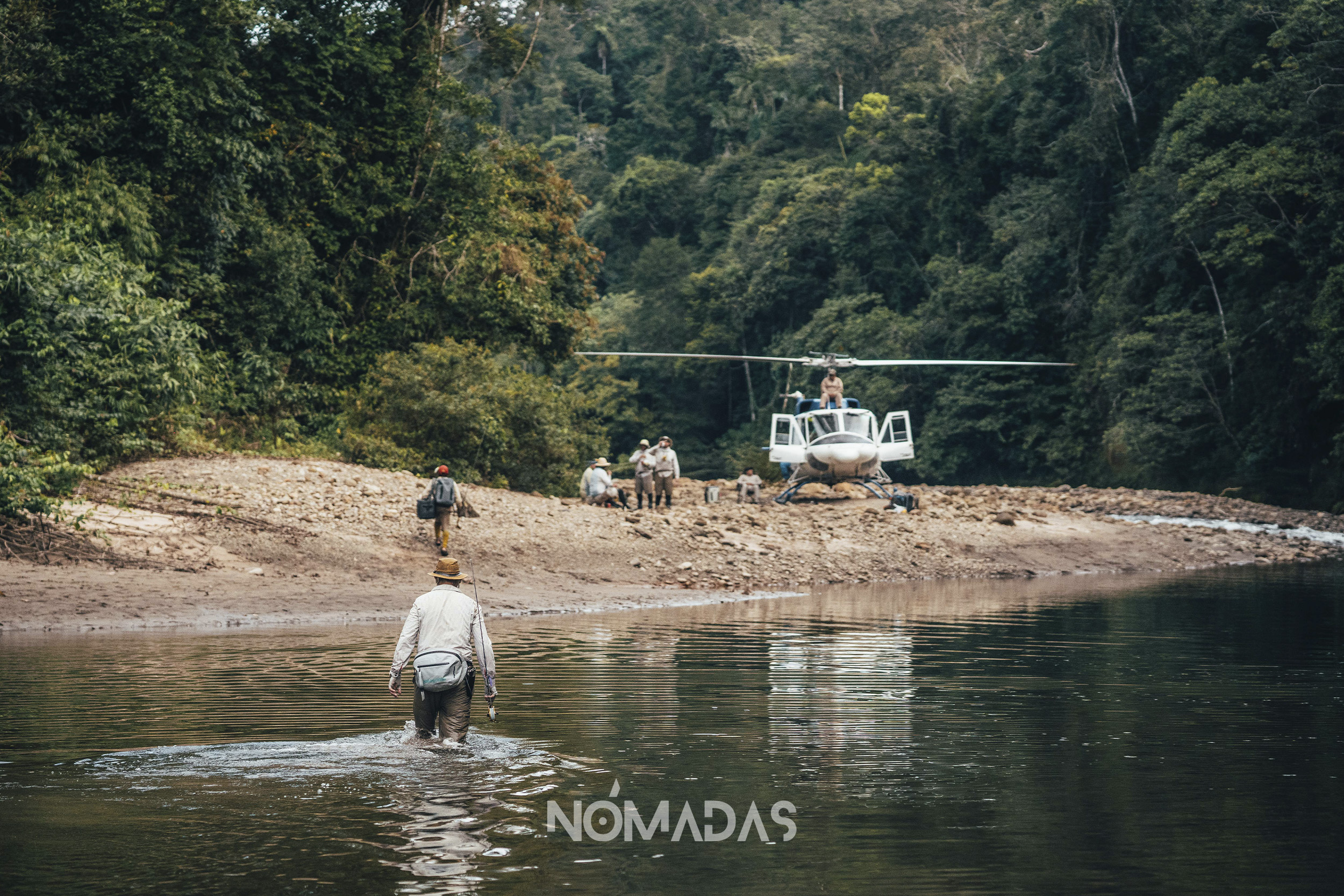
The helicopter lands on a river bank. It leaves the fishermen and returns to pick them up.
At Pluma Lodge, the head chef is Jennifer Waly, the daughter of a Pakistani father and a Brazilian mother who, tired of working in Santa Cruz, remembers going to a job interview and being told first thing: «What we need is a person to work in the jungle.
From above you can also see the interior of the rivers because the waters – crystalline as they are – do not hide any kind of secret.
She said yes and after arriving in the TIPNIS she fell in love with the nature before her eyes.
«I left a way of living in the city, a hectic lifestyle. Here is the simplicity expressed in a quiet place and in harmony with the vegetation and indigenous cultures,» says Waly, who to the cooking knowledge she brought to put into practice, began merging the culinary contributions of the Tsimanes and Yuracarés.
Vicente Llorente is the manager of the entire Pluma Lodge and is in charge of 25 workers, including locals and those who have arrived from Santa Cruz, other parts of Bolivia and Argentina. He is one of the oldest because he arrived at TIPNIS in 2009, and since then he realized – and he has also confirmed it with the opinion of foreign visitors – that there is no other place in the world that has this biodiversity and these dream landscapes, with its rivers where the dorado is the king of fish.
«We have formed a great working team, a perfect symbiosis.
I consider myself lucky. I hope that this paradise lasts a long time, that Bolivia knows how to take care of it and one way to protect it is to bet on sustainable tourism that scares away all the enemies of the environment«, says Vicente, who at the end of each season returns to Argentina, his native country, but after a few weeks he misses the TIPNIS so much that he counts the hours until the day comes to return to meet again the harmonious sounds of the jungle.
When all the visitors have left, the Tsimane workers also pack their bags. The indigenous people leave for their communities and will continue to walk the forest because the nomadic world is at their feet. Gone are the silent shelters. The rivers begin to rise with the first rains that fall from a sky loaded with an immense flock of clouds, which later, merge with the mountains that deliver their waters to the rivers where the dorado that protects the TIPNIS inhabits.
***
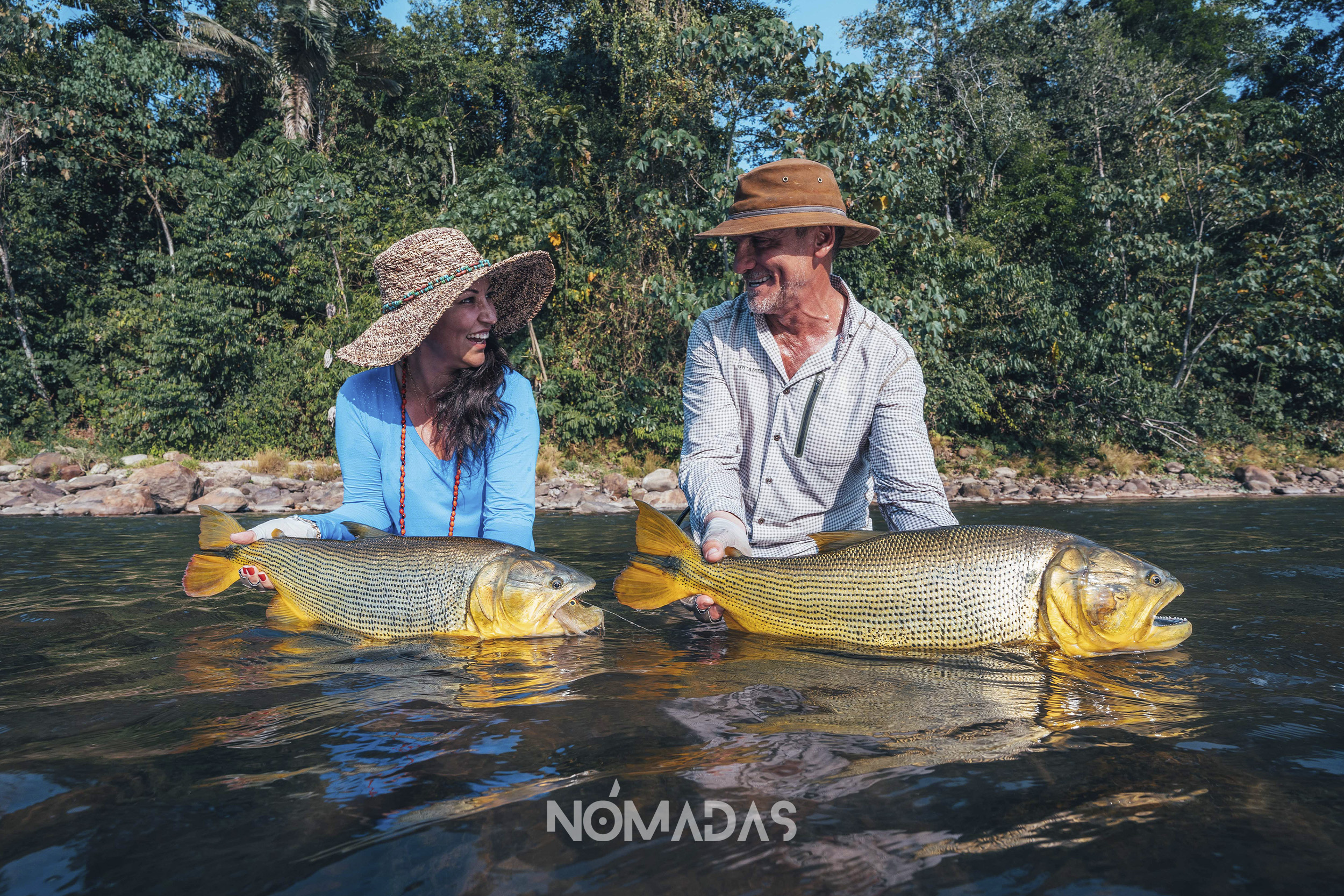
After the photograph, the dorados are returned to the river.
STAFF:
DIRECTION AND TEXTS: Roberto Navia. PHOTOGRAPHY: Daniel Coimbra. TRANSLATION IN ENGLISH, MULTIMEDIA AND SOCIAL NETWORK EDITOR: Lisa Corti. PRODUCTION MANAGER: Karina Segovia. WEB DESIGN AND DEVELOPMENT: Richard Osinaga.
Revista Nómadas – Nomads Journalism ©2023
Te contamos desde el interior de los escenarios de la realidad, iluminados por el faro de la agenda propia, el texto bien labrado y la riqueza poética del audiovisual y de la narrativa sonora, combinaciones perfectas para sentir el corazón del medioambiente y de los anónimos del Planeta.
